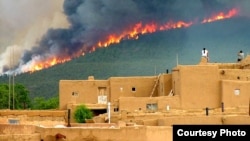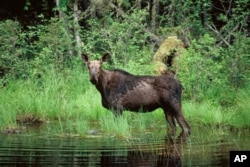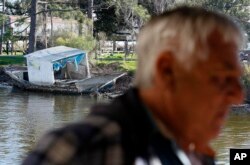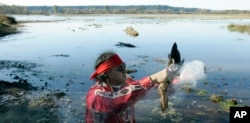Climate change is real; it’s here, and we are on the frontlines of the battle to save America’s land, water and air—that’s the message Native American nations will bring to Washington April 29, the eve of President Donald Trump’s 100th day in office, when they will march against federal policies they say are putting them in danger.
The march is being organized by a coalition of activists formed after the 2014 People’s Climate March, when a record 400,000 people descended on New York City ahead of a U.N. summit on climate change. Among those organizers is Tom Goldtooth (Navajo/Dakota), executive director of the Indigenous Environmental Network, which works to organize North American tribal people around environmental and economic justice issues.
“Populations such as ours that have a close relationship with nature, that still have traditional practices off the land and waterways, are experiencing these real effects, from Alaska to many of our tribal people here in the lower 48,” he said. “Climate change is real. It’s not, as some believe, just some conspiracy theory.”
Goldtooth has seen the effects first-hand in Minnesota, where the New Mexico native now lives.
“We just ended what’s called ‘Sugar Bush’—maple syruping. The seasons change, the weather is unseasonably warm. And all this has impact on weather and when the sap is flowing,” he said. “And it’s the same way with the ‘wild’ rice, which our Dakota people call 'psin'. In certain areas here in the the Great Lakes area, the weather has been very unpredictable, and when water levels are down, it’s very hard to have a harvest of this sacred food.”
Mild winters have led to an increase in the populations of deer ticks and other disease carrying parasites. These have decimated Minnesota’s population of moose, which have provided subsistence to tribes for generations.
Minnesota tribes are not alone, said Garrit Voggesser, director of the National Wildlife Federation’s Tribal Partnership program. He is among the authors of a 2011 report, “Facing the Storm: Indian Tribes, Climate-Induced Weather Extremes, and the Future for Indian Country,” which details the devastating impact of global warming on tribal peoples.
“If you’re asking where climate is most impacting tribes, the simple answer is everywhere,” he said. “Look at Alaska—that’s always the most glaring example—where sea level rise and melting permafrost have forced whole tribal villages to relocate.”
Increasing storm surges in the Pacific Northwest, for example, threaten the cultural and subsistence resources not just of tribes, but the region and nation as a whole. According to the U.S. Environmental Protection Agency, 40 percent of the nation's hydropower is generated by winter snow in the Pacific Northwest and snow melt in springtime. Lower snow levels could reduce the supply of hydroelectricity.
“Looking at the U.S. Southwest—Arizona, New Mexico, Colorado, Utah, California—there’s been a 15-plus-year drought, and so if you look at the Navajo Nation, you see increasing siltation and the creation of sand dunes, which leads to dust storms that impact many, many other things,” Voggesser said.
An when it does rain, the parched earth can’t absorb the water fast enough. This results in floods, erosion and mudslides that can destroy buildings and tear out power lines. To wit: floods in July 2010 left the Hopi First Mesa without potable water or sewage, and they were forced to spend more than $900,000 to repair their infrastructure.
“Some tribes have the capacity and resources and are in a better position to address climate change,” said Voggesser. “Others have barely even started. That’s why it becomes increasingly important for tribes to connect with partners and collaborate, whether that’s at the academic, government or nonprofit level, to identify resources that can help build their capacity.”
Shift in US policy
Tom Goldtooth says tribes feel a special imperative to speak out, in light of a new White House that has shifted focus from energy conservation to energy independence.
“When we have a U.S. administration that is a denier of science and the facts, we have a serious problem that violates our treaty rights to fish and hunt and gather,” said Goldtooth. “Theses aren’t just rights that we negotiated in treaties with the United States. These are inherent rights.”
One of President Trump’s first actions in office was to sign a memorandum advancing the Keystone XL and Dakota Access Pipelines, which tribes fear could contaminate drinking water and destroy sacred sites.
In March, President Donald Trump signed an executive order rolling back the previous administration’s Clean Power Plan, including a moratorium on coal mining on U.S. federal land. That same day, the new secretary of the interior, Ryan Zinke, signed two secretarial orders promoting coal, gas and renewable energy extraction on federal and tribal lands.
Trump’s proposed 2018 budget that would cut the EPA budget by 30 percent. The Interior Department, which is divided into 9 bureaus including the chronically-underfunded Bureau of Indian Affairs, would see cuts of about 12 percent. Last year, the BIA awarded $8.6 million to 85 tribes as part of its Tribal Climate Resilience Program.
Native communities like Washington State’s Swinomish Tribe have reacted with alarm.
“For over 100 years we have lived in a pollution based economy which has caused detrimental damage to the Earth,” said Swinomish tribal spokesperson Debra Lekanoff via email. “We have spent just over 40 years in partnership with the United States to restore and protect what the Creator has provided to us. Today, now more than ever is our time to share a strong message to President Trump that we need to continue to support all of those agencies who put resources into cleaning up the environment.”
It’s a sentiment heard across Indian Country, according to Goldtooth, where tribes are asking Washington, “We’re the ones most feeling the impact. Why are we being forced to change? Why doesn’t the dominant society change what it’s doing to Mother Earth and to our people?















